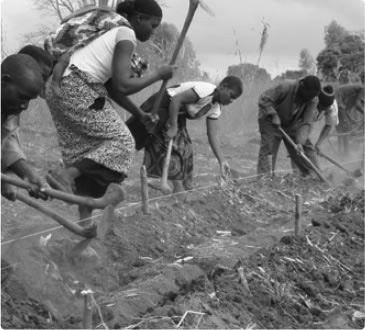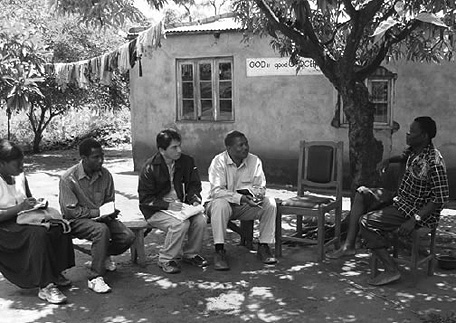Japan's Official Development Assistance White Paper 2011
Column 5
Combine Powers and Resolve Problems!
—Community Afforestation Project in Malawi—

Making ridges with contour farming (Photo: Hiroyuki Kanazawa)
The middle section of the Shire River flowing through northern Blantyre City is an important agricultural area of Malawi and home to the country's largest hydroelectricity plant. The bounties of the highland area are diminishing, however, as an increasing population gathers wood for fuel and plows new land for farming. The resulting decline in forest resources, such as soil erosion and landslides caused by heavy rain obstructing the water flow to the hydropower plant, is endangering the livelihood of the local residents.
At the request of the Malawi Government, Japan conducted several detailed surveys of the area and discovered that the residents need first and foremost a higher income. Hence it launched an open-participation community afforestation project that aims to both revive and preserve the forest and at the same time create an income. For this project (*1) experts in forest management and rural development are dispatched from Japan. One of these experts is Mr. Hiroyuki Kanazawa, who has prior experience in the neighboring country of Zambia. Mr. Kanazawa reflects, "At the start of the project, the biggest challenge was figuring out how to motivate the local farmers to work at their own initiative."
The project in Malawi is carried out in a unique way. The core of the activities is planning and implementing training according to the local farmers' needs, and anyone willing to receive training can join in. When participants in the project's target areas added up to as many as 30,000 households—too many for the extension workers to handle alone—the extension workers decided to foster local instructors in each of the villages. The local instructors are called "lead farmers," and they are chosen by election. These lead farmers receive training from the extension workers, and then act as instructors in their own villages.
At the outset, the training courses covered a wide variety of skills—growing vegetables, beekeeping, freshwater fish farming, soil conservation, forestry, and more. But because holding all these courses in every village in the Middle Shire area would take an eternity, the extension workers have decided to narrow down the training to soil conservation and forestry. As participating villagers come to understand that soil conservation helps to increase the yield of their staple food, maize, and that forest management leads to the prevention of soil erosion and even to an income, word spreads and the training attracts even more participants.
Mr. Alfazema in the village of Mtema is delighted: "I grew maize with the contour farming (*2) I learned about in training, and I got a bigger yield. My house is full of maize." In Chuma, villagers tried their hand at planting the guava tree. They have sent good news that this year the tree started to bear fruit, which they can now both eat themselves and sell to others.
Once a year, the project holds a plenary meeting with the lead farmers and heads of every village. At one such meeting, there was a report that moved Mr. Kanazawa. Mr. Sungeni of Chiwalo village said: "The project is here to help us, but soil conservation is our own problem. For us to make a better living, we must not wait for others to give to us, but combine our powers and resolve problems on our own."
2011 is the International Year of Forests, a year for raising global awareness of forest preservation and restoration. Through the community afforestation project that aims to revive and preserve the forest of the Shire Highlands, Malawian villagers show promising signs of earning a living and ensuring a secure life for themselves in the future.
(*1) Project for community vitalization and afforestation in the Middle Shire (November 2007–November 2012)
(*2) Making ridges for growing crops across a slope along its contour lines to prevent soil erosion

Village hearing survey (Mr. Kanazawa third from left) (Photo: Hiroyuki Kanazawa)
